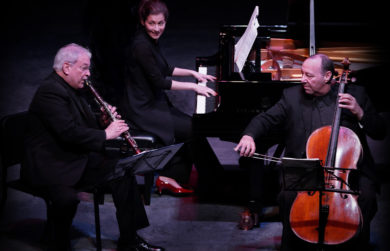Good things in threes: Polonsky, Shifrin and Wiley enchant with a trio of works

David Shifrin, Anna Polonsky and Peter Wiley (l-r) performed works by Beethoven and Alexander von Zemlinsky on Tuesday night in Coral Gables. Photo courtesy of Polonsky-Shifrin-Wiley
Unique arrangements of two early Beethoven works and a musical essay from a gifted young composer in end-of-century Vienna made for a delightful chamber recital on Tuesday night in Coral Gables with the Polonsky-Shifrin-Wiley Trio — former students at Philadelphia’s Curtis Institute of Music who brought keen musicianship and interpretive insight to their Friends of Chamber Music of Miami concert.
Keyboardist Anna Polonsky, clarinetist David Shifrin and cellist Peter Wiley proved to be masters of their instruments individually and exceptional compatriots collectively, their interplay beautifully calibrated inside Coral Gables Congregational United Church of Christ.
In an evening of threes — this was concert No. 3 in the Friends’ seasonal “Masterpiece Series” — the ensemble opened with Beethoven’s sunny, melodically inspired Trio in E-flat major, conceived in 1797 and more frequently heard on violin, cello and piano. With clarinet replacing violin, a sense of serene contemplation and impish playfulness gives the work greater color and warmth, and the score’s surface lightness across three movements in no way masks the Beethoven’s creative ingenuity.
In the initial Allegro con brio, Polonsky’s nimble touch, Shrifrin’s mellow sonority, and the depth and richness of Wiley’s strings produced a subtle melding of textures. Wiley shaped the second movement Adagio’s thematic thread eloquently and at a spacious, unhurried pace. The concluding set of variations on a popular ditty of the era sparkled: Polonsky’s formidable virtuosic command shone impressively in the solo piano episode. An energetic, cascading coda provided the frosting on Beethoven’s great musical confection.
The second composer up, Alexander von Zemlinsky was very much under the spell of Johannes Brahms when he wrote his three-movement Clarinet Trio in D minor in 1896. Replete with Brahmsian romanticism, the 29-minute opus combines surging thematic inventions and long spun motifs, and dramatic, climactic junctures. The haunting principal theme of the first movement Allegro ma non troppo acts as a cyclical connection throughout the entire work. Shifrin gave attentive weight to the moody languor of the Adagio and darting brio to a final Allegro that demanded his clarinet’s full range. The warmth and agility of Shifrin’s playing was balm to jaded ears.
The evening’s finale, Beethoven’s Trio in E-flat major is the composer’s own 1803 arrangement of his Septet for Winds and Strings from three years earlier. In the manner of Mozart’s serenades and divertimentos, its an unabashed entertainment, brimming with high spirits and memorable tunes — a vivid reminder of Beethoven’s power to charm and not just storm the heavens.
This more intimate trio version brings greater clarity to the instrumental lines and simplifies problems of ensemble dynamics and cohesion. An Adagio cantabile, the second of the work’s six movements, is the high point: Here, Shifrin’s clarinet turned the movement’s classical era theme into a meditative lyrical reverie, with Polonsky’s supporting keyboard strokes elegant and well pointed.
The players put spring into the steps of the Tempo di Menuetto and Scherzo movements, and Wiley’s burnished strings throbbed in the dark introduction to the finale, which concluded with an alla marcia and Presto that really danced at a robust clip.
Friends of Chamber Music of Miami present the New York Philharmonic Quartet 8 p.m. Monday, February 13 at Florida International University’s Wertheim Performing Arts Center. miamichambermusic.org
Posted in Performances
Leave a Comment
Wed Jan 18, 2023
at 1:44 pm
No Comments